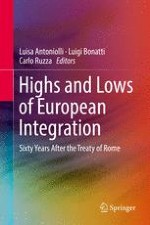2019 | OriginalPaper | Buchkapitel
“United in Diversity”? Differentiated Integration in an Ever Diverse European Union
verfasst von : Luisa Antoniolli
Erschienen in: Highs and Lows of European Integration
Verlag: Springer International Publishing
Aktivieren Sie unsere intelligente Suche, um passende Fachinhalte oder Patente zu finden.
Wählen Sie Textabschnitte aus um mit Künstlicher Intelligenz passenden Patente zu finden. powered by
Markieren Sie Textabschnitte, um KI-gestützt weitere passende Inhalte zu finden. powered by
